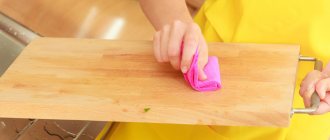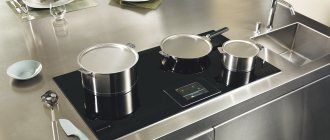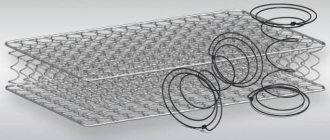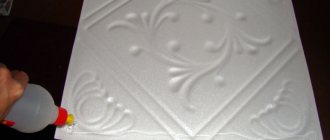The quality and type of knife affect the comfort of use and service life of the product, and, most importantly, the taste and quality of the prepared food. Professional chefs advise not to skimp on this kitchen tool, even when using it at home.
Buy reliable and high-quality sharp kitchen appliances from reputable companies. They will last a long time and will soon pay for themselves. In this article we will look at what knives you need for your home kitchen. And we will learn how to choose the right kitchen knife.
Types of kitchen knives
For each individual job and type of product, a specific suitable knife is made. But that doesn't mean you have to have all kinds. Four appliances are enough in the kitchen. One is for cutting meat and fish, the second is for flour products, the third is for vegetables and fruits. You will also need a Chinese hatchet. You can also purchase additional knives. Experts recommend using separate knives for cutting fish and meat.
- Chef's knife or Japanese Santoku knives are universal products with a blade length of twenty centimeters. Suitable for cutting meat and fish, slicing fruits and vegetables, cheese, sausage and other hard products;
- The serrator is used for cutting bread, loaf and other flour products. It is a product with a large handle. It is distinguished by a long, wavy and serrated blade, the width of which is the same throughout its entire length. The length of the blade reaches 20-25 centimeters. Also suitable for peeling fruits with rough skin, such as pineapple;
- For peeling vegetables and fruits - a tool with a short narrow blade about six to eight centimeters long, a sharp tip and a large, comfortable handle. Some products are also suitable for decorative cutting. In addition, special blades with two holders are made. They are convenient for peeling carrots and potatoes;
- For slicing sausages and cheese - a wide, long blade with a smooth surface without bends;
- For fish - a flexible long blade, equal in width, with serrations;
- Table knives for butter and pate are distinguished by a wide and medium-length blade with a rounded tip;
- For mushrooms - a shortened plastic blade and a handle with a hard brush for cleaning the caps;
- For cutting meat from bones, use a narrow knife of medium length with a curved tip at the end, a widened base and a smooth surface. In addition, they produce separate knives for steaks;
- The Chinese hatchet is used for cutting meat and chopping bones. The product has a powerful, stable handle and a wide blade. Do not cut bones with classic or utility knives, otherwise they will quickly deteriorate.
Today, knives are made from steel and ceramic. A steel product is a classic option, characterized by strength, stability and reliability.
Today, many people choose ceramic devices due to their light weight and simplified use, increased hygiene and blade sharpness. Ceramics does not rust and does not wear down for a long time, but it is a rather fragile material that requires careful care. Let's find out which knives are better - steel or ceramic.
Which knife to choose: steel or ceramic
A steel knife quickly becomes dull, and the blade has to be sharpened every month. This is a durable and reliable material, which increases the practicality and functionality of the metal product. The steel is not so sharp, which ensures safety when using a knife. In addition, the choice of models and designs of steel sharp tools is much wider.
Ceramic products are lighter, making them easier to use. During the cooking and cutting process, your arms, shoulders and back do not get tired for a long time. Ceramics does not absorb or transmit the tastes and odors of different foods. It does not wear down for a long time and will easily last 10-12 months without sharpening. This material does not rust or oxidize and is scratch resistant.
Ceramic knives are easy to clean and can even be put in the dishwasher. It is enough to rinse the blade in water, and it will already get rid of the odors and tastes of other products, as well as dirt. However, ceramics are a brittle material that can be easily chipped and damaged.
Therefore, a ceramic knife cannot be used for cutting meat and frozen foods, or cutting bones. Additionally, a ceramic blade is more difficult to sharpen than a metal blade. Experts advise using several steel products and one or two ceramic ones at home. Let's take a closer look at how to choose knives for the kitchen.
Sharpening with TWINSHARP®
The TWINSHARP sharpening knife with one sharpening module makes it easy and safe to sharpen your blade. The device is easy to use, because, unlike musats, the sharpening angle is already set, which eliminates the possibility of error.
TWINSHARP®Select
With two separate sharpening modules, this new device allows you to sharpen knives easily, safely and effectively. The metal discs of the first module gently eliminate minor unevenness of the cutting edge. In the second module, the edge is lightly polished and the knife becomes sharp again. The knife can be sharpened easily and safely with just a few movements in each module.
In addition, the TWINSHARP®Select sharpener is easy to use for both left- and right-handed people.
The best kitchen knives
| Firm | Description | Price |
| Samura | Ceramic, steel single-layer and multi-layer kitchen knives. Japanese traditions and design, blade hardness from 58 HRC, easy cutting, long-term preservation of factory sharpening when used correctly | From 3,600 rubles for a set of “chef’s troika” and above |
| Wusthof Dreizack | Made of hardened carbon stainless steel, high-quality hand sharpening, corrosion resistance and durability, comfortable ergonomic shape, hygienic propylene handle | 11,000 rubles (set of three knives) |
| Zwilling | High strength and hand sharpening, hardness and overall flexibility, durability and corrosion resistance, blade is made from a single piece of stainless steel | 4,500 rubles (universal) |
| Victorinox | High-quality and reliable products with a hardness of 56, the blade is made of an alloy of steel with carbon, silicon and chromium, molybdenum and manganese; corrosion resistance | 1300 rubles (classic carving knife) |
| Sabatier | High-quality steel blade with mirror polishing, thin and comfortable non-slip handle, rounded base and original design, hygienic | 3600 rubles (universal) |
| Dick | High quality stainless steel narrow blade, light weight and sharp edge, series forged knives | 9000 rubles (forged kitchen knife) |
| GLOBAL | Cold-hardened blade made of steel, molybdenum and vanadium alloy, does not rust, models are sand balanced and made entirely of metal, long service life | 3700 (universal) |
| Arcos | Affordable products with a long service life and high-quality stainless steel blade, aesthetics and originality | 500 rubles (kitchen) |
| Del Ben | Italian handcrafted products with a high-quality stainless steel blade and a fine wood handle, exquisite design, and the Teflon coating of the blade makes it easy to clean. | 5300 rubles (universal) |
| Evercut | High-quality steel knives with an original handle shape, durable and strong, stylish and sophisticated design, easy to use | 7300 rubles (santoku) |
| Kyocera | Ceramic knives, light and sharp, practical and convenient, double degree of ceramic hardening, does not need sharpening and does not retain food odors | 4300 rubles (ceramic utility knife) |
| Tamahagane | Blades made of high-quality Damascus steel, thin edge and double-sided symmetrical sharpening, ergonomic handle and easy use | 5200 rubles (chef's knife) |
| Gude | Monolithic products made of forged steel of increased strength, easy and comfortable use, ergonomics | 7000 rubles (universal) |
| Yaxell | Durable and ductile blade made of high-quality Damascus steel, bending resistance, long service life and expressive design, non-slip ergonomic handle | 5000 rubles (universal) |
Rules for the care and use of knives
We looked at the rating, which included the best knives from all over the world. But improper care can ruin even the highest quality and reliable product. First of all, it is recommended to wash the appliances only by hand and dry them immediately after washing. It is enough to use only warm soapy water.
Wash the product immediately after use to ensure complete hygiene and do not place the equipment in the sink. Under foam or soapy water, you may not be able to see a sharp object and get injured.
Stainless steel and ceramic knives with plastic or metal handles can be washed in the dishwasher, but not often. Sharp objects can damage internal parts and mechanisms and scratch the inside of the machine.
In addition, with frequent and prolonged exposure to hot temperatures and household chemicals, the blade will deteriorate and may bend. Therefore, experts advise washing knives by hand and in warm water using soap without special detergents.
Under no circumstances should knives with wooden handles be placed in a washing machine, nor should they be kept in water or places with high humidity. Due to exposure to moisture and dampness, wood becomes deformed, rots, becomes covered with cracks and mold.
Use cutting boards for cutting, preferably soft plastic or wood. Then the blade will become less dull. Avoid cutting on countertops or tables, and avoid glass or hard stone boards. Use kitchen utensils only for their intended purpose; do not cut bones or frozen foods. Buy separate special tools for these purposes.
A high-quality, expensive knife does not become dull and rarely requires sharpening. When sharpening, follow the rules and choose the appropriate tool. This is a ceramic nutmeg, an electric sharpener or special sharpening systems. How to properly sharpen kitchen knives, see here.
How to choose what to pay attention to
When choosing a steel cutter, it is better to choose one with an “X” symbol on the blade, which means increased anti-corrosion qualities, more durable, and retains its sharpness longer. They are made of high-carbon alloy steel with the addition of vanadium and molybdenum.
Those made from sheet iron will more quickly succumb to dullness and deformation.
The highest quality ceramic blades are not with white, but with dark blades. They withstood a longer hardening period, so they are stronger, sharper, and do not require constant sharpening. They are made from zirconium carbide.
Dishonest manufacturers may offer counterfeits, passing them off as Damascus steel products. A surface laminated to look like Damascus will cost you a lot, but it will not justify itself in terms of practical characteristics.
Where to store kitchen knives
Today there are many different options for storing knives. When storing, it is important that the blades do not break or rub against each other. It is important that hygiene is maintained. Therefore, after washing, wipe the products dry so that moisture does not accumulate in the storage area. This is especially true for holders and stands with narrow openings.
When storing, separate knives by purpose and size. Do not simply put items in a drawer. To do this, you can use a separation tray that is installed in the box. A stylish and functional solution would be to install a box or section built into the countertop.
Popular storage options include stands and magnetic holders. The magnetic holder is a simple and hygienic device that is mounted on the wall. It doesn’t take up space in a drawer or on a countertop, yet it’s inexpensive and always at hand. Magnetic holders are made of wood or trimmed with leather. However, such devices are not safe, since they become accessible to children.
A budget-friendly and simple way to store are stands with vertical slots. These stands are made of plastic, glass or wood. It is important to regularly wash the devices and wipe the knives dry. Otherwise, dirt will accumulate in the holes, which will form harmful bacteria, and the wooden coasters will begin to rot and mold. Therefore, it is not recommended to place wooden stands next to the sink.
Store ceramic knives exclusively in cases. You can use cases for steel products as well. But remember that before putting the knife in the case, the product must be thoroughly washed and wiped dry. For more information on how and where to store knives in the kitchen, see the link.
How to learn to cut quickly with a knife like a chef?
Before you begin, place a napkin soaked in water under the cutting board to prevent slipping. To hold the knife correctly when slicing, you need to grasp it tightly with your index finger and thumb at the junction with the blade. The sharpness of the blade is important for speed. First you need to learn how to chop correctly, then gradually increasing the speed, cut like a chef.
The fruit for training should be divided in half for stability and placed on a board. Take the cutter with one hand, hold the cutter with the other palm, fingers bent halfway, with the thumb hidden inside, constantly bending it and forming a “claw”.
Press the vegetable, the middle bone protrudes slightly. The blade blade touches the bone. Make gentle movements from top to bottom and towards yourself. Gradually move the vegetable forward, without removing the knife from your finger, and make a cut again.
You should not chop with small knives, as it is easier to injure yourself with them or the blade may get stuck in the pulp. Small products must be cut without removing the tip from the board, moving only the handle. The blade is not recommended for use for other work - cleaning or cutting bread products.











